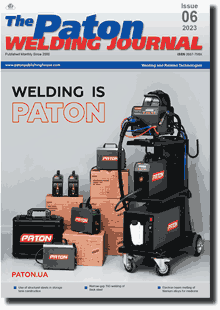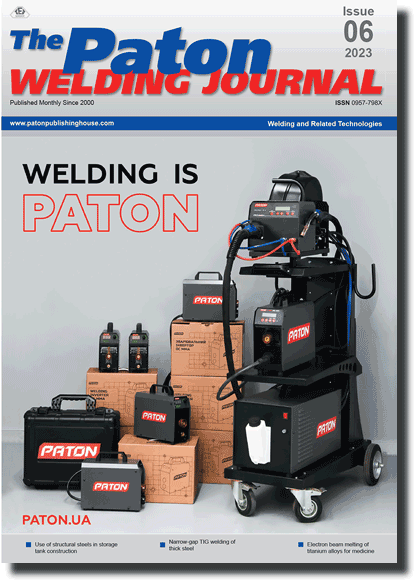| 2023 №06 (07) |
DOI of Article 10.37434/tpwj2023.06.01 |
2023 №06 (02) |

The Paton Welding Journal, 2023, #6, 3-7 pages
Fractal evaluation of grain boundaries branching in the structure of weld metal of low-alloy steels
V.V. Holovko, O.O. Shtofel, V.A. Kostin
E.O. Paton Electric Welding Institute of the NASU. 11 Kazymyr Malevych Str., 03150, Kyiv, Ukraine. E-mail: v_golovko@ukr.netAbstract
Non-metallic inclusions, which are an integral part of welds, can facilitate the reduction in the sizes of structural grains, playing the role of crystallization centers of the weld pool metal. This helps to increase the strength values of the weld metal on the one hand. On the other hand, the crystalline lattice of grains on the grain boundaries is influenced by the force fields of both tangent crystallites, saturated with non-metallic inclusions, impurity atoms, dislocations, vacancies, has an increased energy of grain boundaries. These circumstances contribute to the fact that namely grain boundaries are the places of the highest probability of cracks origination and propagation. For the numerical description of the dualism of the influence of non-metallic inclusions on the weld metal structure, it is proposed to use methods of fractal analysis and metallographic analysis based on artificial intelligence. 7 Ref., 4 Tabl., 3 Fig.
Keywords: low-alloy steel, welding, weld metal, microstructure, fractal analysis, metallographic analysis, MIPAR software
Received: 31.05.2023
Accepted: 17.07.2023
References
1. Priester, L. (2012) Grain Boundaries: From Theory to Engineering Springer Science & Business Media, Dordrecht. https://doi.org/10.1007/978-94-007-4969-62. Reiser, J., Hartmaier, A. (2020) Elucidating the dual role of grain boundaries as dislocation sources and obstacles and its impact on toughness and brittle-to-ductile transition. Scientific Reports, 10, 2739. https://doi.org/10.1038/s41598-020-59405-5
3. Sinha, S., Kim, D-I., Fleury, E. et al. (2015) Effect of grain boundary engineering on the microstructure and mechanical properties of copper containing austenitic steel. Mater. Sci. Eng., 626, 175-185. https://doi.org/10.1016/j.msea.2014.11.053
4. Zhang, I., Lu, C., Tieu, K. (2016) A review on atomistic simulation of grain boundary behaviors in face-centered cubic metals. Computer Mater. Sci., 118, 180-191. https://doi.org/10.1016/j.commatsci.2016.03.021
5. Pogrebna, N.E., Kutsova, V.Z., Kotova, T.V. (2021) Mechanical stability of materials: Tutorial. Dnipro, NmetAU [in Ukrainian].
6. Vasyliev, O.D., Brodnikovska, I.V., Brodnikovskyi, Ie.M. et al. (2018) Interfaces and their influence on properties of polycrystals. Pt 1 (Review). Metaloznavstvo ta Obrobka Metaliv, 1, 44-51 [in Ukrainian].
7. Usov, V.V., Rakkina, M.D., Shkatulyak, N.M. et al. (2014) Fractal dimension of grain boundaties and mechanical properties of oxygen containers. Fiz.-Khimich. Mekhanika Materialiv, 4, 117-124 [in Ukrainian].
Suggested Citation
V.V. Holovko, O.O. Shtofel, V.A. Kostin (2023) Fractal evaluation of grain boundaries branching in the structure of weld metal of low-alloy steels. The Paton Welding J., 06, 3-7.The cost of subscription/purchase order journals or individual articles
| Journal/Currency | Annual Set | 1 issue printed |
1 issue |
one article |
| AS/UAH | 1800 UAH | 300 UAH | 300 UAH | 150 UAH |
| AS/USD | 192 $ | 32 $ | 26 $ | 16 $ |
| AS/EUR | 180 € | 30 € | 25 € | 15 € |
| TPWJ/UAH | 7200 UAH | 600 UAH | 600 UAH | 280 UAH |
| TPWJ/USD | 384 $ | 32 $ | 26 $ | 16 $ |
| TPWJ/EUR | 360 € | 30 € | 25 € | 15 € |
| SEM/UAH | 1200 UAH | 300 UAH | 300 UAH | 150 UAH |
| SEM/USD | 128 $ | 32 $ | 26 $ | 16 $ |
| SEM/EUR | 120 € | 30 € | 25 € | 15 € |
| TDNK/UAH | 1200 UAH | 300 UAH | 300 UAH | 150 UAH |
| TDNK/USD | 128 $ | 32 $ | 26 $ | 16 $ |
| TDNK/EUR | 120 € | 30 € | 25 € | 15 € |
AS = «Automatic Welding» - 6 issues per year;
TPWJ = «PATON WELDING JOURNAL» - 12 issues per year;
SEM = «Electrometallurgy Today» - 4 issues per year;
TDNK = «Technical Diagnostics and Non-Destructive Testing» - 4 issues per year.


